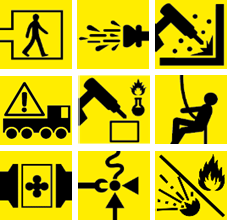Photography and Permit to Work
I’m a big fan of photography, I like taking pictures, I admire the technology and I truly love the results. The principle of photography is simple: ensure you have enough light and don’t move your camera while taking pictures!
To control the light, you have 3 main variables; aperture (opening of a lens’ diaphragm, through which light passes), shutter speed (the length of time when a camera shutter is open), and ISO (the sensitivity of the image sensor). How difficult can it be, especially with all the support of technology and software?
Almost everybody owns a camera and nowadays we all take photos with our phone or camera. Still, you can instantly see the difference in quality between a professional photo and just a photo. The rules for photography are the same for all of us and yes, technology will make some difference, but the real differentiator is the knowledge and experience of the photographer.
My wife doesn’t like to go for a walk with me when I’m in the “photographer” mode. While she’s enjoying the walk and beautiful surroundings, I’m focused on composition, contrast, light, and the million other small things that could make the difference between an ordinary photo and a Pulitzer winner. This focus, in conjunction with taking a lot of pictures, has made me the photographer I am today. Now you might ask yourself: What is the connection between photography and Permit to Work? Well, let me explain…
Why do we need a Permit to Work?
Permit to Work (PtW) is a management system used to ensure that employees work safely in a hazardous environment. Used specifically for high-risk activities, the system allows a person or a group of people to carry out a task under strict controls. Permit to Work is an essential part of Control of Work (CoW); the integrated management of critical maintenance processes. Control of Work combines Permit to Work, Hazard Identification (JHA), Risk Assessment (RA), Isolation Management (IM), and others to form the Operational Risk Management (ORM) system within a plant.
I believe too many companies consider Permit to Work more as a must-do procedure, instead of a valuable system to help employees work safely. The Permit is a written document that authorizes certain people to carry out specific work at a specific time. It sets out the hazards associated with the work and the precautions to be taken. The same Permit helps employees to increase safety awareness about the potential risk and provides specific instructions regarding the appropriate precautions to be put in place. The Permit to Work can be rather complex due to the need to co-ordinate all the required activities, conditions, tools, and precautions, which can become an extensive paper exercise. This gets more complicated still when other paperwork such as certificates are added to the permit. When the paperwork gets the upper hand, then, in my opinion, safety is at stake. The system becomes gradually more bureaucratic. If a site is not careful, the original purpose of creating the safest possible environment to work becomes secondary to the management of the permitting paper process. Resulting in process paperwork experts as opposed to process safety experts!
Electronic Permit to Work
For some time now there has been a trend of replacing paperwork and moving to an electronic Permit to Work. There are good reasons for it:
- Saving time and costs
- Compliancy
- Better audit trail
- Better coordination and communication
You might expect that “increased safety” would appear on the list. However, I believe just replacing paper for electronic Permit to Work will not significantly increase safety. This has been confirmed by several customers who shared their lessons learned and conclusions about their own Permit to Work activities with me. So that begs the question and it’s a big one; why does it not increase safety?
Let’s get back to my example from the beginning. Replacing paper for electronic Permit to Work is like buying a luxury photo camera. With the new camera, you can do more, you have more supporting features and yes, you shoot better photos, but still not comparable with photos from even semi-professionals. The reason why is simple. You cannot buy experience, and you can trust me when I say that for a luxury camera, you still need a lot of experience to take good photos.
What kind of experience does a Permit to Work system need in order to increase safety?
It needs a comprehensive overview and understanding of the risk associated with the task and the necessary precautions to reduce the risk to an acceptable level. These must be communicated in a way that is easy for a worker to understand.
An electronic Permit to Work that merely replaces the old paper system, i.e. when the Risk Assessment process itself remains unchanged, is like buying a new camera without investing in changing the experience of the person who takes the photos. It happens too often; Permits are still submitted without a comprehensive Risk Assessment for a specific task. All the new electronic system does is; allow the plant to get to the same dangerous state, just more efficiently!
What is the real value of Control of Work?
[ot-video][/ot-video]
Last year Yokogawa RAP became a part of the Yokogawa family. This company has developed a truly impressive Control of Work solution. I had the pleasure to talk to the team from management to the software designers. I am pleased to share with you, they have completely and successfully changed my perspective regarding Permit to Work.
Over the last 25 years, the team has materialized their vision into a Control of Work solution called the RAP System. Control of Work is all about integrated management of critical maintenance processes including Risk Assessment. They have re-set things to put critical risk assessment back at the heart of the Permit to Work process.
By putting Risk Assessment at the heart of the permitting process and not the Permit to Work paperwork itself, the designers have ensured that they have created a system that always considers all risks of site activities. They have done this with an intuitive, easy to use system, making safety assessment accessible to all.

- Hazards
- Actions
- Condition measurements
- Exclusion Zones
- Mandatory Requirements
- Personal Protection Equipment (PPE)
The designers of the RAP System software have populated these 500 (& growing) icons with safety information based on millions of hours of Control of Work and permitting experience, so that when you open an icon such as “Roof Work”, you will find all the hazards, actions and personal protection for this specific task, collected over the last 25 years. The user instantly has access to all pertinent safety information thus making it significantly easier to determine what is required for their designated task.
The Risk Assessment is carried out within the process of creating the permit, which ensures that all information is consolidated into the Permit to Work and can be easily communicated to the employees responsible for executing the tasks, giving them all the information they need and none that they don’t.
The tight integration between Risk Assessment and Permit to Work is the real value of a Control of Work System. Doing it right will create a step increase in plant safety.
Does this mean a Control of Work system with 25 years of safety knowledge inside has greater value than a luxury camera? Yes, it does! Besides the nice software features, it also contains a vast amount of field experience, immediately available for use to increase site safety. It is a bit like having that expert photographer I dream of becoming, sitting on my shoulder and whispering in my ear how to get that perfect shot.
Is the right technology all you need?
Do I still need a professional “photographer” for the Risk Assessment and Permit to Work? Of course, you do! Safety is all about knowledge, experience, and leadership of people. However, it is a risk in and of itself to depend only on experts, so it makes sense if we can get help from the system too. When a person, particularly an expert in their field, leaves the company with all the safety knowledge in their head, it makes sense to have the same information in the Control of Work system. With that knowledge, the new person, who will in time become the expert, will be able to take over the role without sacrificing safety.
Coming back to the question “Why do so many electronic Permit to Work projects fail?”. Just replacing paper for an electronic Permit to Work will not really increase safety and while many companies have selected “better safety” as an important driver to justify their electronic Permit to Work investment. Ultimately without safety knowledge built inside the system, these don’t give the benefits they had hoped for and just end up digitizing the paperwork mountain.
An electronic Permit to Work system can become a bureaucratic system. To increase the safety of our colleagues, the holistic approach to Control of Work, including the selection of the electronic solution seems to be the right path forward. It has to be easy to understand, simple to use and with the rigor to withstand any audit process. At the end of the day, if it’s about safety, we only really want to work with a “Professional photographer using a professional camera”.




